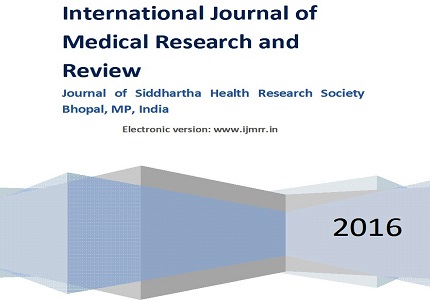Association of bronchial asthma and allergic rhinitis with IgE mediated allergy to common food allergens
Abstract
Background and objective: Prevalence of immunoglobulin (Ig) E-mediated food allergy is primarily reported in patients of all age groups. The present study was aimed to investigate the relative prevalence of food allergy andallergens in patients with bronchial asthma and allergic rhinitis.
Methods: Patients of all age groups and both sexes were screened using standard questionnaire and skin prick-test (SPT) with common foods. Specific IgE level was determined by enzyme linked immunosorbent assay (ELISA) and allergy wasestablished.
Results: Of 575 patients screened, 120 (21%) gave history of food allergy. Of the history positive patients skin testedall showed a marked positive reaction to food extracts. Egg whole, black gram and lemon elicited marked positive SPT reaction in maximum of 12 (10%) cases each followed by rice, mushroom and corn in 11 cases each (9.1%), milk and cheese 10 cases each (8.3%), paneer and sardine fish 9 cases each (7.5%), maize and tamarind 8 cases each (6.6%), peanut and brinjal 7 cases each (5.8%), garlic and cabbage 4 cases each (3.3%), banana, sago and mutton 3 cases each (2.5%0, pineapple, pork, potato and almond with 2 cases each (1.6%), 1 case of beef, lady finger and drumstick (0.8%). The SPT positive patients showed elevated specific IgE levels (range: 0.8-79 IU/mL) againstrespective food allergens than normal controls (0.73 IU/mL, mean±2SD). The prevalence of food allergy was estimated to be 4.5% (2.6%-6.34%)at 95% confidence interval (95% CI) in test population (n=470).
Conclusions: Food allergy is estimated to be 21% in adolescents and adults with asthma, rhinitis or both. Many food allergens were recorded as per the test.
Downloads
References
2. Stazi MA, Sampogna F, Montagano G, Grandolfo ME, Couilliot MF, Annesi-Maesano I. Early life factors related to clinical manifestations of atopic disease but not to skin-prick test positivity in young children. Pediatr Allergy Immunol 2002; 13 (2): 105- 12. [PubMed]
3. Sampson HA. Update on food allergy. J Allergy ClinImmunol2004;113:805-19.
4. Osterballe M, Hansen TK, Mortz CG, Host A, Bindslev- Jensen C. The prevalence of food hypersensitivity in an unselected population of children and adults. Pediatr Allergy Immunol2005;16:567-73. [PubMed]
5. Zuberbier T, Edenharter G, Worm M, Ehlers I, Reimann S, Hantke T, et al. Prevalence of adverse reactions to food in Germany: a population study. Allergy 2004;59:338-45. [PubMed]
6. Roehr CC, Edenharter G, Reimann S, Ehlers I, Worm M, Zuberbier T, et al. Food allergy and non-allergic food hypersensitivity in children and adolescents. ClinExp Allergy 2004;34:1534-41. [PubMed]
7. Tariq SM, Matthews SM, Hakim EA, Arshad SH. Egg allergy in infancy predicts respiratory allergic disease by 4 years of age. Pediatr Allergy Immunol2000;11:162-7. [PubMed]
8. Roberts G, Patel N, Levi-Schaffer F, Habibi P, Lack G. Food allergy as a risk factor for life-threatening asthma in childhood: a case-controlled study. J Allergy ClinImmunol2003;112:168-74. [PubMed]
9. Penard-Morand C, Raherison C, Kopferschmitt C, Caillaud D, Lavaud F, Charpin D, et al. Prevalence of food allergy and its relationship to asthma and allergic rhinitis in schoolchildren. Allergy 2005;60:1165-71. [PubMed]
10. Wang J, Visness CM, Sampson HA. Food allergen sensitization in inner-city children with asthma.J Allergy ClinImmunol2005;115:1076-80. [PubMed]
11. Bozkurt B, Karakaya G, Kalyoncu AF. Food hypersensitivity in patients with seasonal rhinitis in Ankara.AllergolImmunopathol2005;33:86-92. [PubMed]
12. Viswanathan R, Prasad M, Thakur AK, Sinha SP, PrakashN, Mody RK, et al. Epidemiology of asthma in an urbanpopulation: a random morbidity survey. J Indian MedAssoc 1966;46:480-3. [PubMed]
13. Chhabra SK, Gupta CK, Chhabra P, Rajpal S. Prevalenceof bronchial asthma in school children in Delhi. J Asthma1998;35:291-6. [PubMed]
14. Jindal SK, Gupta D, Aggarwal AN, Jindal RC, Singh V.Study of prevalence of asthma in adults of north India usinga standardized field questionnaire. J Asthma 2000;37:345-51. [PubMed]
15. Gaur SN, Sanjay R, Ashish R. Prevalence of bronchialasthma and allergic rhinitis among school children in Delhi.Int Med J Thailand 2004;20:8-13.
16. Parihar H, Kumar L, Puri Kumar V. The incidence ofallergic diseases and feeding patterns in children upto 2years of age.Indian J Paediatr1984;51:7-12. [PubMed]
17. Sharman J, Kumar L, Singh S. Allergenicity of commonfoods restricted in respiratory allergy. Indian J Paediatr2000;67:713-20. [PubMed]
18. Patil SP, Niphadkar PV, Bapat MM. Chickpea: a majorfood allergen in the Indian subcontinent and its clinical andimmunochemical correlation. Ann Allergy Asthma Immunol2001;87:140-5. [PubMed]
19. American Thoracic Society. Lung function testing:selection of reference values and interpretative strategies.Am Rev Respir Dis 1991;144:1202-18.
20. Bousquet J, Cauwenberge PV, Khaltaev N. Allergicrhinitis and its impact on asthma. J Allergy ClinImmunol2001;108:S147-S334. [PubMed]
21. James JM. Respiratory manifestations of food allergy.Pediatr2003;111:1625-30. [PubMed]
22. Hill DJ, Hosking CS, Zhie CY, Leung R, Baratwidjaja K,Iikura Y, et al. The frequency of food allergy in Australiaand Asia.Environ Toxic Pharma 1997;4:101-10. [PubMed]
23. Kumari D, Kumar R, Sridhara S, Arora N, Gaur SN, SinghBP. Sensitisation to blackgram in patients with bronchialasthma and rhinitis: clinical evaluation andcharacterization of allergens. Allergy 2006;61:104-10.
24. Pascual CY, Fernandez-Crespo J, Sanchez-Pastor S,Padial MA, Diaz-Pena JM, Martin-Munoz F, et al. Allergyto lentils in Mediterranean pediatric patients. J Allergy ClinImmunol1999;103:154-8.
25. Mattila L, Kilpeläinen M, Terho EO, Koskenvuo M,Helenius H, Kalimo K. Food hypersensitivity amongFinnish university students: association with atopicdiseases. ClinExp Allergy 2003;33:600-6. [PubMed]
26. PausJenssen ES, Cockcroft DW. Sex differences inasthma, atopy, and airway hyperresponsiveness in auniversity population.Ann Allergy Asthma Immunol 2003;91:34-7.
27. Vally H, Carr A, El-Saleh J, Thompson P. Wine-inducedasthma: a placebo-controlled assessment of itspathogenesis. J Allergy ClinImmunol1999;103:41-6. [PubMed]
28. Perry TT, Matsui EC, Kay Conover-Walker M, Wood RA.The relationship of allergen-specific IgE levels and oralfood challenge outcome. J Allergy ClinImmunol 2004 ;114:144-9. [PubMed]
29. Bollinger ME, Dahlquist LM, Mudd K, Sonntag C, Dillinger L, McKenna K. The impact of food allergy on thedaily activities of children and their families.Ann AllergyAsthma Immunol2006;96:415-21.



 OAI - Open Archives Initiative
OAI - Open Archives Initiative


